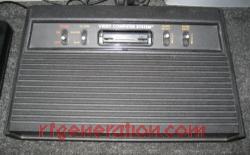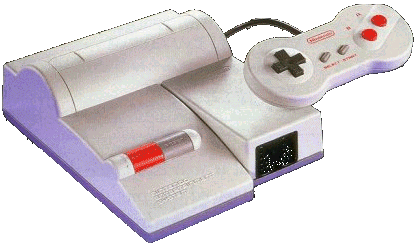
Back in the 1970s, in a time when video games began to increase in popularity after the success of games such as Pong, companies, such as Atari and Magnavox released home versions of the game. Then, Atari's engineers designed a way to play video games at home via cartridges, making it possible for home gamers to own one system, but play many different games. Finally, in October 1977, Atari released the Atari Video Computer System, or Atari 2600. The system didnt become an instant success until around 1978, when Atari gained the rights to the game Space Invaders, and ported it to the 2600, becoming the world's first ever ported arcade game.
Now, like many of you on the site, along with me, consider the Atari 2600 to be one of your favorite video game systems. Many of you may remember the hours you spent in front of your tv playing favorites such as Missile Command, Asteroids, Pitfall!, Berzerk, Combat, Centipede, and Ms. Pac-Man.
Looking at the system, you see that the system is very simple, despite the number of switches on it. Originally, the first run of Video Computer Systems came from the Sunnyvale, California plant with black plastic, a woodgrain front, and six switches. The weight of the system and the number of switches on the front, the early run of the systems became known as the "Heavy Sixer." As time went on, Atari continued to downsize the system. Some revisions were a 6 switch with less weight (Light Sixer), woodgrain front with 4 switches (4 switch woody), and an all-black 4 switch model (the Darth Vader model).
Another good point of the system was the controller. It remains today as one of the simplest controllers for a video game system. The controller is simply a joystick and one button. The other controllers made for the system are the paddle controllers and the driving controller. The paddle controller is a simple spinning knob made for pong and breakout style games. The driving controller was the same as the paddle controller, but the paddle is a continuous 360 degree spin. On top of this, literally hundreds of third party controllers were designed and released for the system.
As the 80s came around, more arcade games made more possibilities of ports for the 2600. Unfortunately, these were also the years when the 2 worst 2600 games were released. First off was the 2600 port of Pac-Man. The biggest problem with the game was the fact that it looked nothing like the original arcade game. This was because of the fact that when Todd Frye, programmer in charge of the game, presented the prototype, Atari released the prototype. Millions bought the game and were extremely disappointed. The other game is the infamous E.T. The Extra-Terrestrial. The game was so bad that the 5 million unsold copies were buried in the New Mexico desert.
In the mid 1980s, fierce competition came from companies such as Nintendo, causing people to begin to abandon the 2600. At this time, Atari redesigned the 2600 as the new Atari 2600 (called the Atari 2600 Jr.), with a new "The Fun Is Back" campaign. This boosted sales of the 2600 for a few years. Finally, Atari discontinued the Atari 2600 in around 1992
As you can see from this review, the Atari 2600 has had a very long and exciting history. As of late, popularity of the 2600 has exploded, and fandom of the system is alive and well. Recently, homebrewers have began creating and releasing brand new Atari 2600 games, via Atariage. http://www.atariage.com/store/ (link to the atariage store)
Even though I wasn't even born when the system was out, it has become one of my highest rated video game systems. This one deserves a perfect 10/10.
In 1989, at a time when the NES was increasing even more in popularity, Sega, who already had some popularity in the United States with the 8-Bit Master System, and Arcade games such as Altered Beast and After Burner II, released a video game console that was meant to take on Nintendo's NES, the Genesis, which became one of the greatest 16-Bit consoles of all time.
At the time of it's release, Sega's main success was in the arcades, and overseas in the UK, where the Master System was extremely popular. On October 29, 1988, Sega release the MegaDrive in Japan. About a year later, on August 14, 1989, Sega release the Genesis in the United States. Sega pushed the Genesis on American consumers with the classic "Genesis does what Nintendon't" commercials. Those who paid the money for the system got the system, controllers, hookups, and the arcade port of Altered Beast. Many of the games released at launch were arcade ports and sports games. These include: Strider, Pat Riley Basketball, James "Buster" Douglas K.O. Boxing, and Michael Jackson's Moonwalker. The graphics of the system made people question why they were still playing on the old 8-Bit NES. Some kept their Nintendo's, and some took the leap into the 16-Bit era. Early in the Genesis' lifetime, Sega released a peripheral for the system called the Sega Power Base Converter. This peripheral slid into the cartridge port of the system an allowed the user to insert Sega Master System games into the converter, giving it backwards compatibility with practically all Master System games, and game Cards.
As the years went on, the Genesis saw some fierce competition coming from Nintendo, with their Super Nintendo Entertainment System, and NEC's TurboGrafx-16. Sega held on, however, and gained even greater popularity with the release of the game Sonic the Hedgehog. Sonic was, as most today know, a blue, bad ass, in-your-face hedgehog, and was much more fierce when compared to Nintendo's little Italian plumber, Mario. Also, Sega was able to beat out Nintendo with one fighting game, Mortal Kombat. While the Genesis version of the game didn't look as good or sound as good as the SNES version, the Genesis version had full blood, and no censored fatalities.
As the Genesis passed into the 32-Bit era, Sega tried to keep up with the graphics of the more advanced systems. They began to push the games to their graphical limits, and even released a couple of add-ons to make the system more powerful. The first of the two was the Sega Mega CD, released in Japan in 1991, and released in the United States in 1992 as the Sega CD. As the name states, this add-on was a disc drive that attached to either the bottom of the model 1 Genesis or on the side of the model 2. The add-on also enabled the Genesis to play audio CDs. Most of the games on the Sega CD were crappy FMV (full motion video) games. Some of the better ones, however, were Sonic CD, Snatcher, The Terminator, and Mortal Kombat. Mortal Kombat on the Sega CD featured the same Genesis graphics, but arcade sounds, speech, and music. Later on, in 1994, Sega released the Sega 32X, which was inserted into the cartridge port of the Genesis, could play all of the regular 16-Bit games, and also had its own line of 32-Bit games such as Mortal Kombat II, Knuckle's Chaotix, Star Wars Arcade, Doom, and Virtua Fighter. These add-ons are infamous for their low amounts of killer titles, and extremely high prices at launch.
In closing, Sega made their greatest benchmark on the video game industry with the Genesis, and many gamers of today swear by the old Blast Processor. This system gets a 8/10.
|
|



